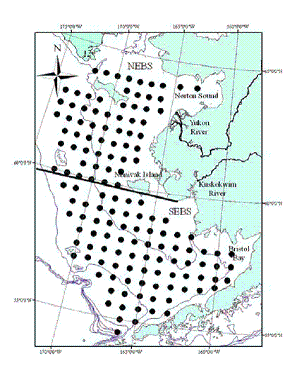

Bering-Aleutian Salmon International Survey (BASIS)
|
Research vessels used for BASIS surveys. |
Recent fluctuations in the abundance, survival, and growth of salmon in the Bering Sea, have added significant uncertainty and complexity to the management of Bering Sea salmon resources. Similar fluctuations in the physical and biological oceanographic conditions have also been observed; however, the limited information on Bering Sea salmon ecology was not sufficient to adequately identify mechanisms linking recent changes in ocean conditions to salmon resources. North Pacific Anadromous Fish Commission (NPAFC) scientists responded by developing BASIS (Bering-Aleutian Salmon International Survey), a comprehensive survey of the Bering Sea epipelagic ecosystem. BASIS was designed to improve our understanding of salmon ecology in the Bering Sea and to clarify mechanisms linking recent changes in ocean conditions with salmon resources in the Bering Sea. The Alaska Fisheries Science Center's Ocean Carrying Capacity Program is responsible for BASIS research in U.S. waters.
 |
Proximate location for stations sampled during the U.S. Bering-Aleutian Salmon International Survey during 2002-06. |
Researchers with the OCC Program have conducted shelf-wide surveys
during fall 2002 through 2006 on the eastern Bering Sea shelf as
part of the multiyear BASIS research program. The focus
of BASIS research was on salmon; however, the broad spatial
coverage of oceanographic and biological data collected during late
summer and early fall provided insight into how the pelagic ecosystem
on the eastern Bering Sea shelf responded to changes in spring productivity.
Salmon and other forage fish (e.g., age-0 walleye pollock, Pacific
cod, and Pacific herring) were captured with a surface net trawl,
zooplankton were collected with oblique bongo tows, and oceanographic
data were obtained from conductivity-temperature-depth (CTD) vertical
profiles.
|
Chum salmon with Age-0 Walleye pollock |
Supporting Research
- Helle, J., E. Farley, J. Murphy, A. Feldmann, K. Cieciel, J. Moss, L. Eisner, J. Pohl, and M. Courtney. 2007. The Bering-Aleutian Salmon International Survey (BASIS). AFSC Quarterly Report Feature (January-February-March 2007), 5 p.
- Farley, E.V., Jr., J.M. Murphy, M.D. Adkison, L.B. Eisner, J.H. Helle, J.H. Moss, and J. Nielsen. 2007. Early marine growth in relation to higher survival for Bristol Bay sockeye salmon (Oncorhynchus nerka). Fishery Bulletin 105:121 - 130.
- Grebmeier, J.M., J.E. Overland, S.E. Moore, E.V. Farley, Jr., E.C. Carmack, L.W. Cooper, K.E. Frey, J.H. Helle, F.A. McLaughlin, S.L. McNutt. 2006. A major ecosystem shift in the northern Bering Sea. Science 311:1461 - 1464.
- Farley, E.V., Jr., J.M. Murphy, B.W. Wing, J.H. Moss, and A. Middleton. 2005. Distribution, Migration Pathways, and Size of Western Alaska Juvenile Salmon Along the Eastern Bering Sea Shelf. Alaska Fishery Research Bulletin 11:15-26.
- Eisner, L.B., E.V. Farley, and J.M. Murphy. 2006. Variations in juvenile sockeye and age-0 pollock distribution during fall 2000-2005 in the eastern Bering Sea- BASIS. In: Ecosystems Considerations Chapter for 2007, edited by J. Bolt, Alaska Fisheries Science Center, NOAA, Seattle, WA. Online
See the publications and posters databases for additional listings.
To view and print these documents, you must install
Adobe Acrobat Reader
freeware. Adobe also offers
free tools
for the visually disabled
|